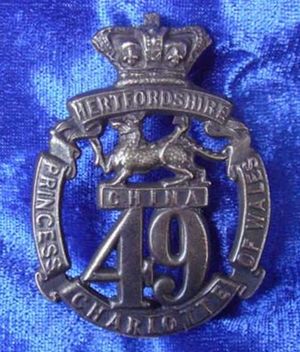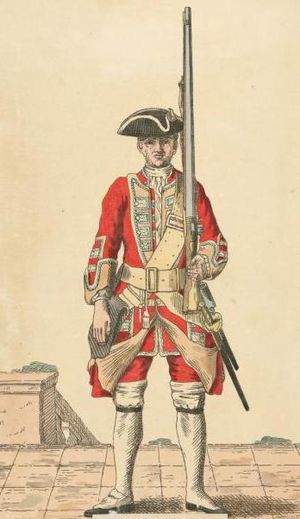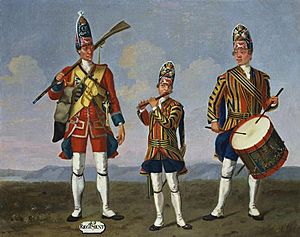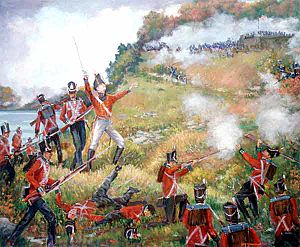49th (Princess Charlotte of Wales's) (Hertfordshire) Regiment of Foot facts for kids
Quick facts for kids 49th (Princess Charlotte of Wales's) (Hertfordshire) Regiment of Foot |
|
|---|---|

Cap badge of the 49th (Princess Charlotte of Wales's) (Hertfordshire) Regiment of Foot
|
|
| Active | 1743 to 1881 |
| Country | |
| Branch | |
| Type | Line infantry |
| Role | Infantry |
| Size | One battalion (two battalions 1813–1814) |
| Garrison/HQ | Brock Barracks, Reading |
| Engagements | American Revolutionary War French Revolutionary Wars War of 1812 First Opium War Crimean War |
The 49th (Princess Charlotte of Wales's) (Hertfordshire) Regiment of Foot was a special group of soldiers in the British Army. They were a type of infantry (soldiers who fight on foot) and were first formed in 1743. This regiment served for many years. In 1881, it joined with another regiment, the 66th (Berkshire) Regiment of Foot. Together, they became the Princess Charlotte of Wales's (Royal Berkshire Regiment).
Contents
History of the 49th Regiment
How the Regiment Started
The 49th Regiment began in Jamaica in 1743. A leader named Colonel Edward Trelawney created it. He brought together eight smaller groups of local soldiers. At first, it was called "Edward Trelawney's Regiment of Foot."
In 1747, it was known as the 63rd Regiment. Then, in 1751, it officially became the 49th Regiment of Foot. The soldiers moved to Ireland in 1764 and stayed there for a while. Later, in 1772, they sailed to Newfoundland.
Fighting in the American Revolutionary War
In June 1775, the regiment moved to Boston to fight in the American Revolutionary War. They took part in several important battles. These included the Battle of Long Island in August 1776 and the Battle of White Plains in October 1776. They also fought at the Battle of Fort Washington in November 1776.
Later, they were part of the Philadelphia campaign. They saw action at the Battle of Brandywine in September 1777. They also fought at the Battle of Paoli and the Battle of Germantown in October 1777. After the Battle of Brandywine, the regiment started wearing red feathers in their hats. This was a special mark to show who they were.
In 1778, the regiment sailed to the West Indies. They helped the British win the Battle of St. Lucia in December 1778. Then, in 1780, they returned to Ireland. In 1782, the regiment was given a special name: the 49th (the Hertfordshire) Regiment of Foot.
Wars in Europe and North America
In 1793, the soldiers of the regiment were given a new role. They became marines, which meant they could serve on ships. They were sent to protect Dominica in 1794 during the French Revolutionary Wars.
After returning to England in 1796, they went to Ostend in 1798. They took part in a large attack in Holland in 1799. They fought in the Battle of Alkmaar in October 1799. They also served in the Battle of Copenhagen in April 1801.
After their time as marines, the regiment moved to Canada in 1802. They served under a brave leader, Major-General Sir Isaac Brock. They fought in the War of 1812 at the Battle of Queenston Heights in October 1812.
The regiment returned home in 1815. They had a special job guarding the Royal Family at Weymouth. The soldiers wore bright red coats and white trousers. Princess Charlotte of Wales was so impressed by them that she wanted her name linked to the regiment. So, in 1816, they became the 49th (Princess Charlotte of Wales's) (or the Hertfordshire) Regiment of Foot.
Later Years and Big Changes
In 1840, the regiment was sent to China to fight in the First Opium War. They fought in several battles there. These included the Capture of Chusan in July 1840 and the Battle of Canton in March 1841. They also fought at the Battle of Amoy in August 1841. The regiment also helped take over Shanghai in 1842. They returned home in 1843.
In early 1854, the regiment went to fight in the Crimean War. They were involved in major battles like the Battle of Alma in September 1854. They also fought at the Battle of Inkerman in November 1854. They took part in the long Siege of Sevastopol in 1854. After these tough battles, they returned home in 1856.
In the 1870s, the British Army made some big changes. The 49th Regiment was linked with the 66th (Berkshire) Regiment of Foot. They shared a training base in Reading. On July 1, 1881, the two regiments officially joined together. They formed the Princess Charlotte of Wales's (Royal Berkshire Regiment).
Battle Honours
Battle honours are special awards given to regiments for their bravery in battles. Here are some of the honours the 49th Regiment earned:
- Egmont-op-Zee, Copenhagen, Queenston, China
- Crimean War: Alma, Inkerman, Sevastopol
- St. Lucia 1778 (This honour was given to the regiment that followed them in 1909.)
Victoria Crosses
The Victoria Cross is the highest award for bravery in the British military. These brave soldiers from the regiment received it:
- Lieutenant John Augustus Conolly, for his actions in the Crimean War (October 26, 1854)
- Corporal James Owens, for his actions in the Crimea War (October 30, 1854)
- Sergeant George Walters, for his actions in the Crimea War (November 5, 1854)




